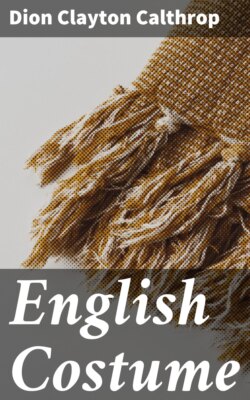Читать книгу English Costume - Dion Clayton Calthrop - Страница 14
THE MEN
ОглавлениеThe Father of Popular Literature, Gerald of Wales, says: ‘It is better to be dumb than not to be understood. New times require new fashions, and so I have thrown utterly aside the old and dry methods of some authors, and aimed at adopting the fashion of speech which is actually in vogue to-day.’
Vainly, perhaps, I have endeavoured to follow this precept laid down by Father Gerald, trying by slight pictures of the times to make the dry bones live, to make the clothes stir up and puff themselves into the shapes of men.
It is almost a necessity that one who would describe, paint, stage, or understand the costume of this reign should know the state of England at the time.
For there is in this reign a distinction without a difference in clothes; the shapes are almost identical to the shapes and patterns of the previous reigns, but everybody is a little better dressed.
The mantles worn by the few in the time of William the Red are worn now by most of the nobility, fur-lined and very full.
One may see on the sides of the west door of Rochester Cathedral Henry and his first wife, and notice that the mantle he wears is very full; one may see that he wears a supertunic, which is gathered round his waist. This tunic is the usual Norman tunic reaching to the knee, but now it is worn over an under-tunic which reaches to the ground in heavy folds.
One may notice that the King’s hair is long and elegantly twisted into pipes or ringlets, and that it hangs over his shoulders.
A MAN OF THE TIME OF HENRY I. (1100-1135)
His hair is curled in ringlets; he wears a long cloak. The shirt shows at the neck of the tunic. The small design in the corner is from a sanctuary door-knocker.
No longer is the priestly abuse of ‘filthy goat’ applicable, for Henry’s beard is neatly trimmed and cut round his face.
These two things are the only practical difference between the two dates—the end of the eleventh century and the beginning of the twelfth.
The under-tunic was made as a perfectly plain gown with tight sleeves ending at the wrist; it hung loose and full upon the figure. Over this was worn the short tunic with wide sleeves ending at the elbow. Both tunics would have broad borders of embroidered work or bands of coloured material. The supertunic would be brooched by one of those circular Norman brooches which was an ornamental circle of open gold-work in which stones and jewels were set. The brooch was fastened by a central pin.
The extravagances of the previous reign were in some measure done away with; even the very long hair was not fashionable in the latter half of this reign, and the ultra-long sleeve was not so usual.
So we may give as a list of clothes for men in this reign:
A white linen shirt.
A long tunic, open at the neck, falling to the ground, with tight sleeves to the wrist.
A short tunic reaching only to the knees, more open at the neck than the long tunic, generally fastened by a brooch.
Tight, well-fitting drawers or loose trousers.
Bandages or garters crossed from the ankle to the knee to confine the loose trousers or ornament the tights.
Boots of soft leather which had an ornamental band at the top.
Socks with an embroidered top.
Shoes of cloth and leather with an embroidered band down the centre and round the top.
Shoes of skin tied with leather thongs.
Caps of skin or cloth of a very plain shape and without a brim.
Belts of leather or cloth or silk.
Semicircular cloaks fastened as previously described, and often lined with fur.
The clothes of every colour, but with little or no pattern; the patterns principally confined to irregular groups of dots.
And to think that in the year in which Henry died Nizami visited the grave of Omar Al Khayyám in the Hira Cemetery at Nishapur!
A CHILD OF THE TIME OF HENRY I.
It is only in quite recent years that there have been quite distinct dresses for children, fashions indeed which began with the ideas for the improvement in hygiene. For many centuries children were dressed, with slight modifications, after the manner of their parents, looking like little men and women, until in the end they arrived at the grotesque infants of Hogarth’s day, powdered and patched, with little stiff skirted suits and stiff brocade gowns, with little swords and little fans and, no doubt, many pretty airs and graces.
One thing I have never seen until the early sixteenth century, and that is girls wearing any of the massive head-gear of their parents; in all other particulars they were the same.
